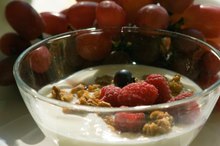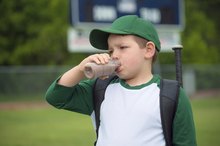Good Food for a Skinny Boy to Gain the Weight
**Boys often feel pressure to put on pounds when they're on the thinner side 3.
While you might be tempted to offer pizza and milkshakes to help your son add bulk to his skinny frame, he's better off with high-calorie, healthy foods. ** Consult your pediatrician before making changes to your son's diet.
Weight Gain for Skinny Boys
In weight control, it all starts with calories 1. For your son to gain weight, you need to make sure he's eating enough calories; the total number depends on his age and activity.
**Young boys ages 4 to 8 years need 1,200 to 2,000 calories a day.
** Boys 9- to 13 need 1,600 to 2,600 calories, and teen boys ages 14 to 18 need 2,000 to 3,200 calories. The higher end of the calorie range in each age group is for boys who are more active.
To help promote weight gain, you may need to up your son's daily intake by 250 to 500 calories, which may help add 1/2 to 1 pound a week to his thin frame.
For healthy weight gain that promotes muscle and bone growth, most of the calories your son eats should come from nutrient-rich sources.
- In weight control, it all starts with calories 1.
- To help promote weight gain, you may need to up your son's daily intake by 250 to 500 calories, which may help add 1/2 to 1 pound a week to his thin frame.
High-Calorie Whole Grains
Eating Plan for a 15-Year-Old Girl
Learn More
Grains are a good source of calories for boys, along with carbs, B vitamins and iron; to help your son get the most calories out of every bite, include higher-calorie grains in his diet.
Good options include cereals such as Grape Nuts and granola, each with more than 200 calories per half-cup serving.
Also, calorie-dense breads such as bagels and slices of hearty whole-wheat or pumpernickel.
You can also use wheat germ, which has 26 calories per tablespoon, as a calorie booster. Add it to hot cereal, baked goods, smoothies or yogurt.
- Grains are a good source of calories for boys, along with carbs, B vitamins and iron; to help your son get the most calories out of every bite, include higher-calorie grains in his diet.
- You can also use wheat germ, which has 26 calories per tablespoon, as a calorie booster.
Good Protein Options
Meat, poultry, seafood, beans and soy foods are all good protein foods for your boys 23. Protein is an important nutrient for growth, and it supports immune health and maintenance of tissue 3.
**To boost calories and help meet protein needs, add ground meat or poultry to soups, macaroni and cheese, pizza or salad.
** Eggs, including a whole egg with 80 calories and the yolk with 55 calories, also make a good source of extra calories. Blend cooked yolks with mashed potatoes or sauces. Chop boiled eggs and add to veggie and grain salads.
- Meat, poultry, seafood, beans and soy foods are all good protein foods for your boys 2.
- To boost calories and help meet protein needs, add ground meat or poultry to soups, macaroni and cheese, pizza or salad.
Dairy Food for Skinny Boys
Weight-Gain Diet for Girls
Learn More
Boys need milk for their growing bones, and milk and other dairy foods are also a good way to add extra calories 2. Start by making a high-calorie milk by mixing 1 cup of nonfat dried milk powder with a quart of whole milk to create a milk with 210 calories per cup. Use the mixture in cereal or when making mashed potatoes, soup, macaroni and cheese or milkshakes. Cheese is a high-calorie, kid-friendly food with 70 to 120 calories per ounce 3. Add to sandwiches, veggies, baked potatoes, crackers or serve it as a snack. For between-meal drinks, make calorie-dense smoothies using whole milk, Greek yogurt and higher-calorie fruit such as banana and mango.
Nuts, Seeds and Oils
Nuts, seeds and oils are calorie-dense foods that make good calorie boosters for your boys to help promote weight gain 2.
Spread peanut butter on an apple or celery sticks for a healthy high-calorie snack; two tablespoons of peanut butter has 188 calories. Or, add chopped walnuts or almonds to tossed greens or a grain dish.
Nut butters and ground flaxseed, which has 37 calories per tablespoon, can also be added to a fruit smoothie or milkshake for a little boost. Instead of serving your son boiled or steamed veggies, saute them in oil. **Each tablespoon adds 124 calories.
** Oil can also be used to cook meat or tossed with oven-browned potatoes, roasted veggies or salad. For an on-the-go snack, mix nuts and dried fruit in a plastic zipper bag and stash in your son's backpack.
- Nuts, seeds and oils are calorie-dense foods that make good calorie boosters for your boys to help promote weight gain 2.
- Nut butters and ground flaxseed, which has 37 calories per tablespoon, can also be added to a fruit smoothie or milkshake for a little boost.
Fruits and Veggies Are Important, Too
Most fruits and vegetables are low in calories, but they are an important part of your boy's diet, providing essential vitamins and nutrients such as vitamins A and C and fiber.
But some fruits and veggies are higher in calories than others 23. Avocados, for example, have 117 calories per half-cup; add slices to sandwiches or salad.
Dried fruit also makes a good option for your thin boy to help up calories for weight gain 2. Include a small box of raisins, which has 129 calories, with his luncheon meat in school lunches or add dried fruit to his dinner salad. Starchy vegetables, such as potatoes, peas and corn, also make good higher-calorie options to add to meals to help promote healthy weight gain.
- Most fruits and vegetables are low in calories, but they are an important part of your boy's diet, providing essential vitamins and nutrients such as vitamins A and C and fiber.
- Starchy vegetables, such as potatoes, peas and corn, also make good higher-calorie options to add to meals to help promote healthy weight gain.
Related Articles
References
- NHS Choices: Underweight Teen Boys
- HealthyChildren.org: Energy In: Recommended Food and Drink Amounts for Children
- Women and Children's Health Network: Kid's Health: Food Groups
- U.S. Department of Health and Human Services and U.S. Department of Agriculture. 2015–2020 Dietary Guidelines for Americans. 8th Edition. December 2015.
- Hall KD, Chow CC. Why is the 3500 kcal per pound weight loss rule wrong?. Int J Obes (Lond). 2013;37(12):1614. doi:10.1038%2Fijo.2013.112
Writer Bio
Jill Corleone is a registered dietitian and health coach who has been writing and lecturing on diet and health for more than 15 years. Her work has been featured on the Huffington Post, Diabetes Self-Management and in the book "Noninvasive Mechanical Ventilation," edited by John R. Bach, M.D. Corleone holds a Bachelor of Science in nutrition.









